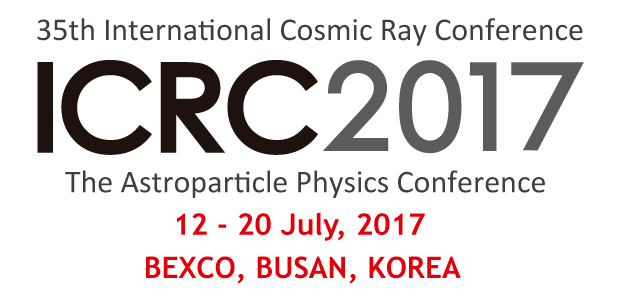
Summer is a hot season for science conferences. And in astrophysics, the International Conference on Cosmic Rays (ICRC2017) was a must. This recent event had a strong WIPAC presence, with six talks and and seven posters presented by our researchers, covering new results and future developments for the neutrino observatories ARA and IceCube, the gamma-ray detectors HAWC and the Fermi Large Area Telescope(LAT), and outreach projects such as DECO and the wide-reaching IceCube education and outreach program. The ten-day conference ended on July 20, in Busan, Korea, with the exciting announcement that UW–Madison will be hosting ICRC2019.
IceCube talks summarized results on a search for neutrino emission from fast radio bursts and a search for PeV gamma rays using IceCube and IceTop, both of which drew a blank but allowed setting new limits on the expected neutrino and gamma-ray emissions. Results from searches for tau neutrinos and an updated cosmic ray (CR) anisotropy map with IceCube were shown in the poster sessions, together with a summary of collaboration-wide efforts in education and outreach.
A joint IceCube-HAWC talk presented the first CR anisotropy map of the full sky from combined data from both observatories. The map shows an anisotropy in the arrival direction distribution of 10-TeV cosmic rays that extends across both hemispheres.
Another team at WIPAC also presented studies of the CR anisotropy using data from Fermi LAT. The all-sky measure of protons with energies between 78 GeV and around 10 TeV shows a significant quadrupole anisotropy component that is still under investigation.
The HAWC team also had a poster presentation about a search for gamma-ray bursts (GRB), which includes an all-sky search as well as fast follow-ups of GRBs reported by satellites.
As ARA prepares for a new deployment season, WIPAC researchers presented both results from searches for ultra-high-energy neutrinos and ongoing developments for the new stations as well as planned measurements to learn more about the properties of the Antarctic ice, which limit the reconstruction of neutrino-induced radio signals in ARA.
Finally, the WIPAC-led citizen science project DECO also presented a poster outlining new efforts to improve the identification of cosmic-ray muons detected by cell phones using the DECO app.
Plans for the next ICRC conference are already in progress at WIPAC in collaboration with the Department of Physics at UW–Madison, which will bring a thousand astrophysicists to Wisconsin from around the world. This is an extraordinary venue to showcase the great science done in Madison!
